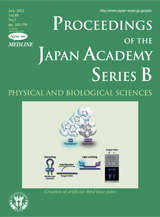About the Cover
Vol. 88 No. 7 (2012)
Why does DNA only use four different bases? Is it possible to compose an alternative biology system with different base sets or increased numbers of base types? For more than 20 years, researchers have struggled to create extra base pairs (unnatural base pairs) that function as a third base pair in artificial biology systems, including replication, transcription, and/or translation. Synthetic DNA molecules with six different bases, generated by introducing unnatural base pairs, could be used as templates for the enzymatic site-specific incorporation of extra components into DNA, RNA, and protein.
With pioneering spirit, Dr. Hirao’s group has developed several types of unnatural base pairs for practical use in in vitro biology systems. By addition of two new unnatural bases (Ds and Px) to the four canonical bases (T, C, A, and G), they have recently succeeded in creating a six-base system where an unnatural base pair (Ds−Px) could function in PCR with extremely high efficiency and selectivity. Other unnatural base pairs are utilized in transcription and/or translation. Furthermore, the modifications of these unnatural base pairs endow them with unique fluorescent properties. Dr. Hirao and Dr. Kimoto describe their work, on pages 345 to 367. These unnatural base pair systems have revealed the numerous possibilities enabled by the expansion of the chemical diversity of genetic materials, and are now being applied to diagnostics, therapeutics, and DNA nanotechnology. This new synthetic biology area is opening the door to novel biotechnology.
Professor, Graduate School of Bioscience and Biotechnology, Tokyo Institute of Technology




